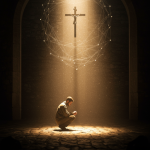Today is Trinity Sunday. It’s so darned easy to take that for granted—to listen to the Gospel with the ears of someone who has heard that old story s-o-o-o many times before, then to drive back home, mow the lawn and enjoy your Sunday dinner and maybe a movie.
But wait! What is this “three persons in one God” stuff really about?
The word “Trinity” never shows up in the Bible; but with the eyes of faith, you can find it all over the place. Remember when Jesus was baptized by John in the Jordan River—and God the Father spoke from the clouds, saying “This is my beloved Son in whom I am well pleased.” The Holy Spirit was there too, manifesting Himself as a dove.
Then in Matthew 28:19, Jesus instructed the disciples, telling them “Go and make disciples of all nations, baptizing them in the name of the Father, and of the Son, and of the Holy Spirit.”
St. Patrick tried to explain the mystery of the Trinity using a prop—a humble shamrock. The little shamrock has three leaves, but is only one plant, Patrick
explained to the Irish people; likewise, our great and mighty God is three
persons in one God. In “St. Patrick’s Breastplate,” his morning prayer, Patrick prays:
I bind unto myself today
The strong Name of the Trinity,
By invocation of the same,
The Three in One and One in Three.
Others have used the analogy of an egg—which consists of egg shell, egg white and yolk—or H2O which can take the form of liquid (water), solid (ice) or gas (steam).
C.S. Lewis had a good approach: In Mere Christianity, Lewis compared the
Trinity to the three Dimensions in space.
You know that in space you can move in three ways – to left or right, backwards or forwards, up or down. Every direction is either one of these three or a compromise between them. They are called the three Dimensions. Now notice this. If you are using only one dimension, you could draw only a straight line. If you are using two, you could draw a figure: say, a square. And a square is made up of four straight lines. Now a step further. If you have three dimensions, you can then build what we call a solid body: say, a cube – a thing like a dice or a lump of sugar. And a cube is made up of six squares.
Do you see the point? A world of one dimension would be a straight line. In a two-dimensional world, you still get straight lines, but many lines make one figure. In a three-dimensional world, you still get figures but many figures make one solid body. In other words, as you advance to more real and more complicated levels, you do not leave behind you the things you found on the simpler levels: you still have them, but combined in new ways – in ways you could not imagine if you knew only the simpler levels.
Now the Christian account of God involves just the same principle. The human level is a simple and rather empty level. On the human level one person is one being, and any two persons are two separate beings – just as, in two dimensions (say on a flat sheet of paper) one square is one figure, and any two squares are two separate figures. On the Divine level you still find personalities; but up there you find them combined in new ways which we, who do not live on that level, cannot imagine. In God’s dimension, so to speak, you find a being who is three Persons while remaining one Being, just as a cube is six squares while remaining one cube. Of course we cannot fully
conceive a Being like that: just as, if we were so made that we perceived only two dimensions in space we could never properly imagine a cube. But we can get a sort of faint notion of it. And when we do, we are then, for the first time in our lives, getting some positive idea, however faint, of something super-personal – something more than a person. It is something we could never have guessed, and yet, once we have been told, one almost feels one ought to have been able to guess it because it fits in so well with all the things we know already. (Harper Collins version, p161-162)
The Catechism of the Catholic Church explains this great mystery, which is held true not only by Catholics but by all Christians:
“The mystery of the Most Holy Trinity is the central mystery of Christian faith and life…. It is therefore the source of all other mysteries of faith, the light that enlightens them. It is the most fundamental and essential teaching in the hierarchy of the truths of faith. The whole history of salvation is identical with the history of the way and the means by which the one true God, Father, Son, and Holy Spirit, reveals Himself to Men and reconciles and unites with Himself those who turn away from Him.
“The Trinity is a mystery of faith in the strict sense, one of the mysteries that are hidden in God, which can never be known unless they are revealed by God. To be sure, God has left traces of His Trinitarian being in His work of creation and in His Revelation throughout the Old Testament. But his inmost Being as Holy Trinity is a mystery that is inaccessible to reason alone or even to Israel’s faith before the Incarnation of God’s Son and the sending of the Holy Spirit.”
(Catechism of the Catholic Church, nos. 233, 234, and 237)











